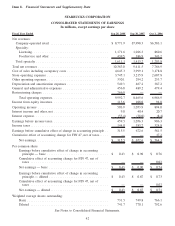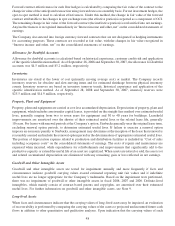Starbucks 2008 Annual Report Download - page 45
Download and view the complete annual report
Please find page 45 of the 2008 Starbucks annual report below. You can navigate through the pages in the report by either clicking on the pages listed below, or by using the keyword search tool below to find specific information within the annual report.
Equity Security Price Risk
The Company has minimal exposure to price fluctuations on equity mutual funds within its trading portfolio. The
trading securities approximate a portion of the Company’s liability under the MDCP. A corresponding liability is
included in “Accrued compensation and related costs” on the consolidated balance sheets. These investments are
recorded at fair value with unrealized gains and losses recognized in “Interest income and other, net” in the
consolidated statements of earnings. The offsetting changes in the MDCP liability are recorded in “General and
administrative expenses.” The Company performed a sensitivity analysis based on a 10% change in the underlying
equity prices of its investments, as of the end of fiscal 2008, and determined that such a change would not have a
significant effect on the fair value of these instruments.
Interest Rate Risk
The Company utilizes short-term and long-term financing and may use interest rate hedges to manage the effect of
interest rate changes on its existing debt as well as the anticipated issuance of new debt. At the end of fiscal years
2008 and 2007, the Company did not have any interest rate hedge agreements outstanding.
The following table summarizes the impact of a change in interest rates on the fair value of the Company’s debt (in
millions):
September 28, 2008
Fair Value
100 Basis Point Increase in
Underlying Rate
100 Basis Point Decrease in
Underlying Rate
Change in Fair Value
Debt ........................ $1,251 (35) 35
The Company’s available-for-sale securities comprise a diversified portfolio consisting mainly of fixed income
instruments. The primary objectives of these investments are to preserve capital and liquidity. Available-for-sale
securities are investment grade and are recorded on the consolidated balance sheets at fair value with unrealized
gains and losses reported as a separate component of “Accumulated other comprehensive income.” The Company
does not hedge the interest rate exposure on its available-for-sale securities. The Company performed a sensitivity
analysis based on a 100 basis point change in the underlying interest rate of its available-for-sale securities as of the
end of fiscal 2008, and determined that such a change would not have a significant effect on the fair value of these
instruments.
APPLICATION OF CRITICAL ACCOUNTING POLICIES
Critical accounting policies are those that management believes are both most important to the portrayal of the
Company’s financial condition and results, and require management’s most difficult, subjective or complex
judgments, often as a result of the need to make estimates about the effect of matters that are inherently uncertain.
Judgments and uncertainties affecting the application of those policies may result in materially different amounts
being reported under different conditions or using different assumptions.
Starbucks considers its policies on asset impairment, stock-based compensation, operating leases, self insurance
reserves and income taxes to be the most critical in understanding the judgments that are involved in preparing its
consolidated financial statements.
Asset Impairment
When facts and circumstances indicate that the carrying values of long-lived assets may be impaired, an evaluation
of recoverability is performed by comparing the carrying values of the assets to projected future cash flows, in
addition to other quantitative and qualitative analyses. For goodwill and other intangible assets, impairment tests are
performed annually and more frequently if facts and circumstances indicate goodwill carrying values exceed
estimated reporting unit fair values and if indefinite useful lives are no longer appropriate for the Company’s
trademarks. Upon indication that the carrying values of such assets may not be recoverable, the Company
recognizes an impairment loss as a charge against current operations. Judgments made by the Company related to
39
























